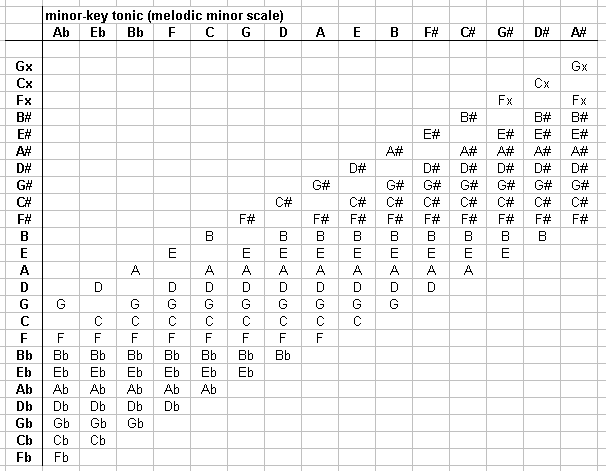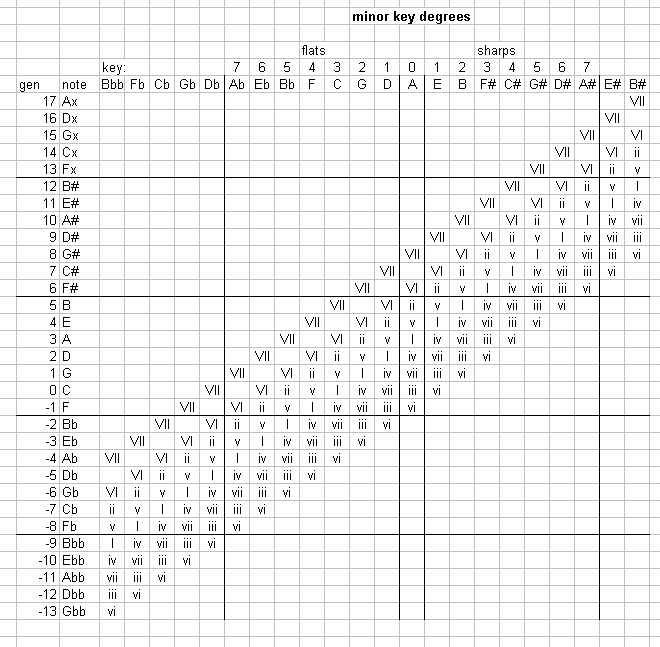minor mode, minor scale
One of the two principal modes in modern music (the other being the major mode).
There are three different types of minor scale: "natural", "harmonic", and "melodic", and two types of relationship between minor and major scales: "parallel" and "relative". For purposes of describing the two types of relationship, the "natural minor" will be used.
- In the "relative" relationship, the "natural minor" scale has exactly the same notes as its "relative major" scale, but because the scale is considered to start and end on a different note, the intervallic pattern of tones ("whole-steps") and diatonic-semitones ("half-steps") between the notes is different. The "relative minor" scale's starting note is found by ascending 6 "steps" (or equivalently, by descending 3 "steps") to the 6th degree of the major scale -- for example, from the scale of C-major, one may find the relative minor by ascending C D E F G A, thus it is said that "A-minor is the "relative minor of C-major", or equivalently, "C-major is the relative major of A-minor".
- In the "parallel" relationship, the major and minor scales start and end on the same note, but some of the actual notes in the scale are different: specifically, the 3rd, 6th, and 7th degrees of the "natural minor" version of the minor-scale are one chromatic-semitone (colloquially called "half-step") lower than in that scale's "parallel major" -- for example, the scale of C-major contains the notes C D E F G A B, and the scale of C-minor contains C D Eb F G Ab Bb.
As for the three varieties of the minor-scale:
- The "natural minor" is derived entirely from the relative major-scale, as described above.
- In the "harmonic minor" version of the minor-scale, the 7th degree is raised one chromatic-semitone ("half-step") higher than in the "natural minor" form; thus for example, the "C harmonic-minor" scale is C D Eb F G Ab B. The "harmonic minor" is so called because it is the type of minor-scale from which the standard set of chords in a minor key are derived. Its main distinctive feature, harmonically, is that the "dominant" chord (whose "root" is on the 5th degree, designated with Roman-numeral "V") is a major-chord, whereas V is minor in the "natural minor" form.
- The "melodic minor" form is the most complicated, in that it has two different sets of notes and thus two different intervallic "step" patterns, depending on whether the scale is being considered with the pitches ascending or descending. In descending order of pitch the notes are exactly the same as those of the "natural minor" version, but in ascending order of pitch the 6th and 7th degrees are raised one chromatic-semitone ("half-step") higher than the "natural minor" form. Thus, for example, the C-melodic-minor scale is ascending: C D Eb F G A B C and descending: C Bb Ab G F Eb D C. The chords used with this form are generally those derived from the "harmonic minor" form, but chords derived from the "natural minor" form may also be used.
The "melodic minor" form contains all of the notes found in all three forms of minor-scale, thus it may be used to illustrate all of the minor-scales in the different keys. Below is a table showing the complete set of melodic-minor scales which occur in standard meantone-based musical notation.

Below is a similar table, this time showing all 31 notes in the standard meantone-based notation on the left (along with their generator numbers, with C as zero), and the scale-degree Roman-numerals in the body of the table. The "natural" form of the minor-scale is composed of the notes which are indicated by lower-case letters (i, ii, iii, iv, v, vi, vii); the "harmonic" and "melodic" forms make use of raised 6th and 7th degrees, which are indicated with capital letters (VI and VII). Horizontal lines separate groups of pitches which have the same accidental (or lack of one), while vertical lines separate the 15 standard keys which have key-signatures (7 with flats, 7 with sharps, and one with neither, plus several others on either end which normally do not have an associated key-signature).
(The reasons for a cardinality of 31 may be found in the discussions of 31edo and 1/4-comma meantone.)

The chord-qualities of the chords on each degree of the harmonic-minor scale are shown below, first for triads then for tetrads; the example is in A-minor:
triads:
D
C
B B
A A
G# G# G#
F F F
E E E
D D
C C
B
A
I II III IV V VI VII
m o + m M M o
tetrads:
F
E
D D
C C
B B B
A A A
G# G# G# G#
F F F
E E E
D D
C C
B
A
I II III IV V VI VII
m,M7 /o7 +,M7 m7 x7 M7 o7
legend:
m minor
M major
/o half-diminished
o diminished
x dominant
+ augmented
The Natural Minor Mode is the tritriadic scale whose Tonic, Subdominant and Dominant triads are Minor Triads (1/1 6/5 3/2) on 1/1, 4/3 and 3/2. The scale 1/1 9/8 6/5 4/3 3/2 8/5 9/5 2/1.
The C or Lydian Octave Species of the P.I.S. whose tetrachords are tuned as 10/9 x 9/8 x 16/15.
The A Mode (Hypodorian) mode of P.I.S. in 12-tone ET or one with close approximation to the Perfect Fifth, i.e., the scale 0 2 3 5 7 8 10 12/0 [in 12-edo degrees].
There are two other common forms of the Minor Mode, the Harmonic Minor whose upper tetrachord is 3/2 8/5 15/8 2/1 and the Melodic Minor with 3/2 5/3 15/8 2/1.
The tonalsoft.com website is almost entirely the work of one person: me, Joe Monzo. Please reward me for my knowledge and effort by choosing your preferred level of financial support. Thank you.
